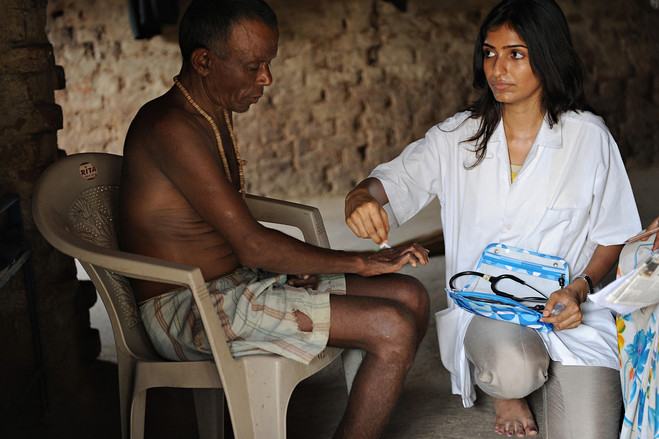Private versus Public Health Care in India
In an important paper in the latest AER, Das, Holla, Mohpal and the excellent Karthik Muralidharan compare private and public health care in India. (I once asked, “Is any economist doing more important work with greater potential for real improvement in the lives of millions than Karthik Muralidharan?” See previous posts on Karthik’s work for the answer.)
The AER paper examines health care in villages in Madhya Pradesh, one of the poorer states in India (GDP per capita of $1,500 PPP). In India, primary health care is ostensibly available for free from public health clinics and hospitals manned by professionally trained nurses and physicians. As with teachers at public schools, however, it’s very common for doctors at public clinics to be absent on any given day (40% were absent on a given day in 2010) and public clinics are not highly regarded. As a result, some 70% percent of primary care visits nationally–and an even higher percentage in Madhya Pradesh–are to private, fee-charging health-care providers. Most of the private providers do not have a license or medical degree although they may have some health-care training.
 The authors sent trained actors, “standardized patients” to public and private clinics to evaluate provider effort and accuracy in response to the presentation of textbook symptoms of common illnesses (angina, asthma, and dysentery in a child at home). Standardized patients are used to train medical students in the United States and in India and the Indian SPs were trained by professionals including medical doctors, and a medical anthropologist familiar with local forms of presenting illnesses and symptoms.
The authors sent trained actors, “standardized patients” to public and private clinics to evaluate provider effort and accuracy in response to the presentation of textbook symptoms of common illnesses (angina, asthma, and dysentery in a child at home). Standardized patients are used to train medical students in the United States and in India and the Indian SPs were trained by professionals including medical doctors, and a medical anthropologist familiar with local forms of presenting illnesses and symptoms.
The first result is that the provision of health care is uniformly and distressingly poor. Overall, only 2.6% of patients received a correct treatment (and nothing unnecessary or harmful). The private providers, however, exert much more effort than do the public providers. The private providers, for example, perform more items on a standard checklist and they spend more time with patients. But the private providers are no better than the public providers at giving a correct treatment. Why not?
Private providers exert more effort but are less knowledgeable. Loosely we might say that Quality=Effort*Knowledge. Private providers put in more effort but have less knowledge and public providers have more knowledge but put in less effort leading to similar quality levels overall.
There is one big difference, however, between the public and private regimes, the private regime is much less socially costly. Since costs are lower and the quality level is the same, the private system is much more productive. The authors note:
…our estimates suggest that the public health care system in India spends at least four times more per patient interaction but does not deliver better outcomes than the private sector
(FYI, this also holds true for public and private schooling in India and around the world. Private schooling is usually somewhat better or about as good as public schooling but much less costly so the productivity of private schooling is much higher.)
To focus on the issue of market incentives rather than knowledge the authors do a second set of remarkable tests. Indian doctors often work in a public and a private practice. Thus, the authors send standardized patients to the same doctors but in one case the patient is treated under the public regime and in other under the private, market regime. Once knowledge is controlled for the results are very clear, private, markets dominate the public regime.
…treatments provided in the private practice strictly dominate those provided in the public practice of the same doctor. The rate of correct treatment is 42 percent higher (16 percentage points on a base of 37 percent), the rate of providing a clinically non-indicated palliative treatment is 20 percent lower (12.7 percentage points on a base of 64 percent), and the rate of antibiotic provision is 28 percent lower (13.9 percentage points on a base of 49 percent) in the private practice relative to the public practice of the same doctor.
The bottom line is that the private market for health care is much bigger and less expensive than the public health regime in rural India and once we control for knowledge it’s of higher quality. These results have important implications for reform. In particular, much more effort should go into improving the knowledge of the private sector.
….the marginal returns to better training and credentialing may be higher for private health care providers who have stronger incentives for exerting effort. Current policy thinking often points in the opposite direction, with a focus on hiring, training, and capacity building in the public sector on one hand (without much attention to their incentives for effort), and considerable resistance to training and providing legitimacy to unqualified private providers on the other.